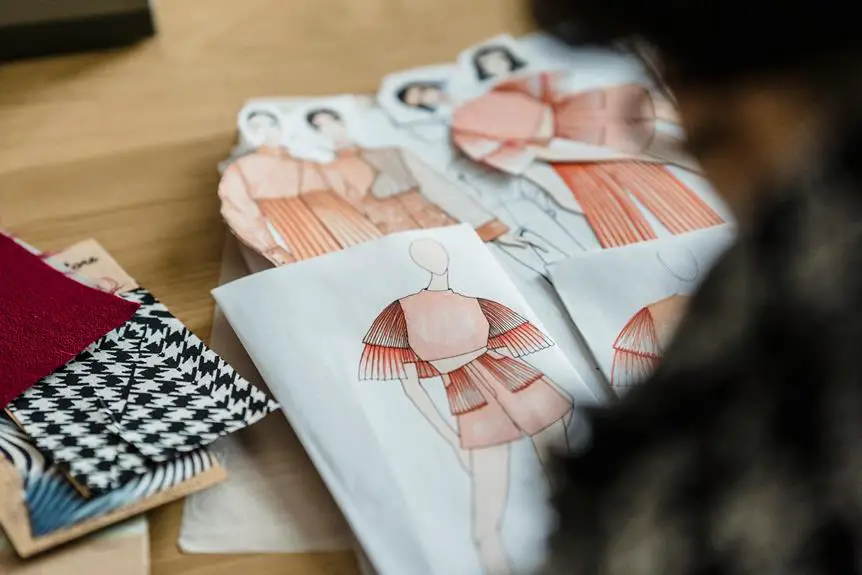When you're tackling a craft project that requires fabric stiffness, it's crucial to choose the right method for your needs. You might consider options like glue solutions, fabric stiffeners, or even simple homemade mixtures. Each technique offers a unique level of firmness and finish, but the application process can vary significantly. By understanding these differences, you can select the best approach for your specific project. So, what are the most effective methods to achieve that perfect stiffness without compromising the fabric's integrity?
Table of Contents
Key Takeaways
- Choose a stiffening method like glue solution, fabric stiffener, or spray starch based on the desired firmness for your project.
- Prepare a homemade solution such as a flour slurry or sugar-water mix for a cost-effective alternative to commercial products.
- Apply the stiffening solution evenly, ensuring the fabric is clean and free of oils for optimal results.
- Allow ample drying time after application to ensure the stiffness holds and the fabric retains its shape.
Understanding Fabric Stiffening
Fabric stiffening is a technique that gives materials a firmer structure, making them ideal for various craft projects. When you want your fabric to hold its shape or resist wrinkling, stiffening is the way to go. This method enhances the fabric's durability, allowing you to create beautiful, functional items that maintain their form over time.
You might use stiffened fabric for projects like table runners, decorative bows, or even ornaments. Understanding the properties of the fabric you're working with is crucial, as different materials react differently to stiffening agents. Cotton may absorb stiffening solutions well, while synthetics may require specific methods for optimal results.
Knowing why you want to stiffen your fabric helps guide your choices. If you're aiming for a soft yet structured look, you'll want to choose a gentle stiffening method. Conversely, if you need maximum rigidity, you might select a stronger option.
Ultimately, experimenting with different techniques can lead to stunning creations tailored to your needs. So, before diving into your next craft project, consider how stiffening can elevate your design and functionality.
Common Stiffening Methods
When you're ready to stiffen your fabric, several common methods can help you achieve the desired firmness for your craft projects.
One popular option is using a glue solution. Mix equal parts white school glue and water, then apply it to your fabric. This method works well for lightweight materials and dries clear.
Another effective technique is using fabric stiffener, which you can find in craft stores. Simply follow the manufacturer's instructions for dilution and application. Often, you'll soak your fabric in the solution and then shape it as needed.
If you prefer a more natural approach, consider using a sugar-water mixture. Dissolve one part sugar in two parts water, then soak the fabric. This method creates a temporary stiffness, perfect for projects that won't be exposed to moisture.
You can also use a spray stiffener for quick application. Just spray the solution onto your fabric and shape it as desired.
Finally, there's the option of heat-setting, where you can use an iron to activate certain fabric treatments, providing an additional layer of firmness.
Each method has its benefits, so choose the one that best suits your project!
Using Starch for Stiffening
Starching your fabric is a straightforward way to achieve a crisp finish that's perfect for craft projects. To start, gather your materials: fabric, starch, water, and a spray bottle or bowl for soaking.
If you're using spray starch, simply shake the can and hold it about 6 to 8 inches away from the fabric. Lightly mist the fabric, ensuring even coverage. If you prefer soaking, mix equal parts starch and water in a bowl, then submerge the fabric for a few minutes.
After soaking, wring out the excess liquid gently and lay the fabric flat on a clean surface. You can also roll it up in a towel to absorb additional moisture.
Next, iron the fabric using a medium heat setting. The heat activates the starch, giving your fabric a firm and structured look.
Keep in mind that the amount of starch you use can affect the stiffness. For a light hold, use less starch; for a firmer finish, apply more. If you find the fabric too stiff, you can always rinse it out.
With practice, you'll find the right balance for your specific craft project.
Alternative Homemade Solutions
If you're looking for alternatives to commercial starch, there are several homemade solutions that can effectively stiffen your fabric without the need for store-bought products. These DIY methods are not only cost-effective but can also be made with items you probably already have at home.
Here's a quick comparison of some popular homemade stiffening solutions:
| Solution | Ingredients |
|---|---|
| Flour Slurry | 1 cup flour, 4 cups water |
| Sugar Solution | 1 cup sugar, 4 cups water |
| White Glue Mixture | 1 part white glue, 2 parts water |
| Vinegar & Water Mix | 1 cup vinegar, 2 cups water |
To create these solutions, simply mix the ingredients in a bowl until smooth. For best results, apply your chosen mixture to the fabric using a spray bottle or brush. Allow it to dry completely before using or displaying your project. These alternatives provide a flexible yet firm finish, making them ideal for various craft projects. Don't hesitate to experiment and find the perfect solution for your needs!
Tips for Best Results
To achieve the best results with your fabric stiffening, always ensure your fabric is clean and free of any dirt or oils before applying the stiffening solution. This initial step sets the stage for a smooth and effective process.
Here are a few more tips to enhance your outcome:
- Choose the Right Stiffening Solution: Different projects may require different levels of stiffness. Experiment with varying solutions, such as commercial products or homemade alternatives, to find what works best for your specific fabric.
- Apply Evenly: When applying the stiffening solution, make sure to do so evenly. Use a paintbrush or spray bottle to coat the fabric thoroughly. This prevents uneven stiffness and helps maintain the fabric's natural drape.
- Allow to Dry Completely: After applying the solution, give your fabric ample time to dry. Rushing this step can lead to a less durable finish. Depending on the solution, drying may take several hours, so be patient.
Frequently Asked Questions
Can I Use Stiffening Methods on Delicate Fabrics?
Yes, you can use stiffening methods on delicate fabrics, but be cautious. Always test a small area first to avoid damage. Consider using lighter solutions or diluted formulas to maintain the fabric's integrity while achieving stiffness.
How Long Does Fabric Stiffening Last After Application?
The duration of fabric stiffening depends on the method and conditions. Generally, it can last from a few days to several weeks. If exposed to moisture or wear, it might weaken faster than expected.
Is Fabric Stiffening Reversible if I Change My Mind?
Yes, fabric stiffening can be reversible, but it depends on the type of stiffener used. If you change your mind, you can often soak or wash the fabric to soften it again.
Are There Specific Fabrics That Shouldn't Be Stiffened?
Certain fabrics, like silk or delicate lace, shouldn't be stiffened because they can lose their structure and become damaged. Always test a small area first to ensure the fabric responds well to stiffening techniques.
Can I Mix Different Stiffening Methods for Better Results?
Yes, you can mix different stiffening methods for better results. Combining spray starch with fabric stiffener or using heat and starch together often gives you more control over the fabric's texture and overall stiffness.
- Tetron Fabric for Marine Applications: Durability and Use Cases - June 18, 2025
- Tetron Fabric for Outdoor Furniture: Weather Resistance and Care - June 18, 2025
- Tetron Fabric for Wall Coverings: Style and Application Tips - June 18, 2025






